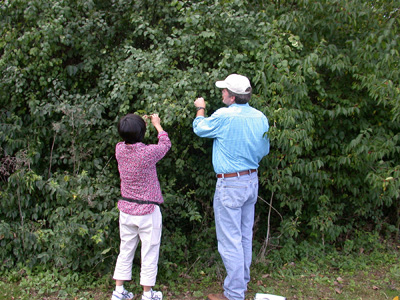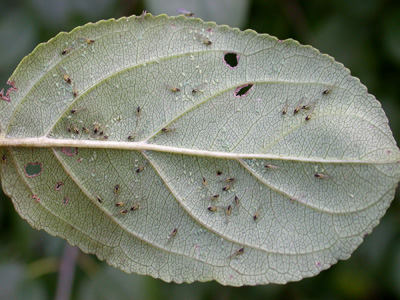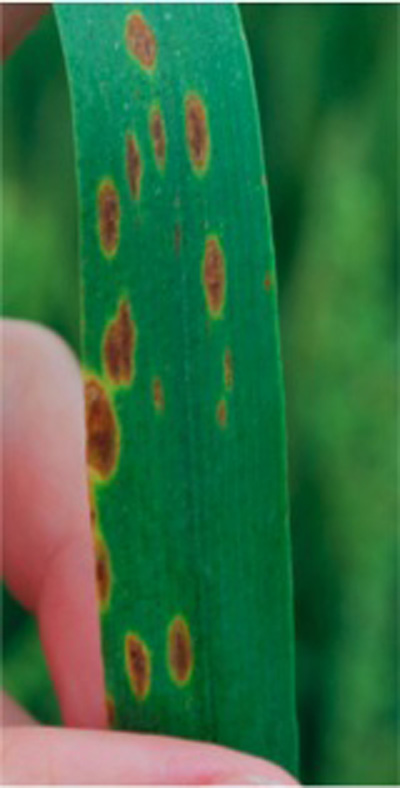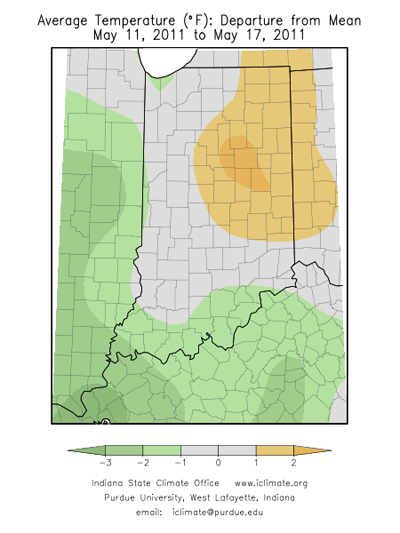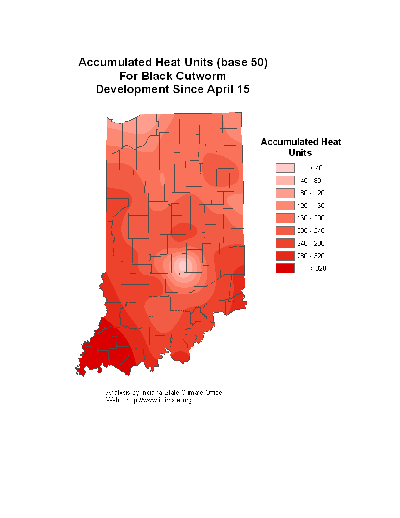Soybean Aphid: First Update - (Christian Krupke and John Obermeyer)
• Soybean aphid numbers extremely low on buckthorn, after low suction trap numbers in fall, this was expected.
• Indicates low risk of infestation on Indiana soybeans prior to late summer.
• As in previous years, “buckthorn-heavy” states to the north and west will determine aphid pressure for most of Indiana.
First soybean aphid update of the year – they are out there, but not many of them. Many of you will recall that soybean aphid has a complex life cycle that requires another host plant – buckthorn. This woody shrub is a native of Asia, as are soybean aphid and soybeans. When soybeans are not present, soybean aphids require this plant to reproduce upon. Most importantly, this period includes the overwintering egg stage.
Many of you may recall previous issues of Pest&Crop that have chronicled aphid sampling trips through Indiana, Illinois, Ohio and Michigan in spring and fall to assess how many aphids made it to buckthorn, how many eggs they laid, numbers of predators, winter survival etc. These trips, led by Dr. David Voegtlin, emeritus of the Illinois Natural History Survey, consist of visits to known aphid overwintering sites and can be a useful indicator of what to expect in terms of soybean aphid pressure later. For example, a visit to these areas in fall of 2009, (when we had extremely high numbers of winged aphids throughout the Midwest), revealed that many of the aphids that reached buckthorn were killed by pathogenic fungi and natural enemies. Counter-intuitively, very few eggs went into overwintering that year with a result of very low pressure in 2010. Here is Dr. Voegtlin’s report from last week’s survey:
Buckthorn being inspected for soybean aphid
“Last Wednesday through Friday I made my annual spring trip to survey for the soybean aphid on buckthorn. After the very low numbers recorded in the suction trap network last fall I was not expecting to find much, if anything. General locations visited on these trips are the Rome City area in N.E. Indiana, Toledo area, Irish Hills in S. E. Michigan, Kellogg Forest near Battle Creek, Michigan, Calumet area S. of Chicago, Joliet, IL and Quad Cities area. A number of colonies were found at the Kellogg Forest area and Quad Cities sites. After extensive searching in the Rome City area only one colony was found. No soybean aphids were found at any other locations. Given the cool spring weather the development has apparently been slow. Colonies had only wingless adults and nymphs. No winged aphids were observed and I did not see any natural enemies associated with any of the colonies. This is more than I expected to find. I think that in years with very low fall flight the aphids that do make it to buckthorn are in such low numbers that the predators do not find them. A few egg layers on one plant is not enough to attract the predators and they can successfully deposit eggs. The opposite seems to happen in years of high fall flight. Predators, particularly Asian lady beetle, flock to heavily infested trees in such high numbers that there are no female aphids that reach maturity and deposit eggs.”
What does all this mean for Indiana? Probably only that the risk of spring/early summer treatable aphid infestations is quite low. Typically, we get most of our pressure later in the season (early to mid-August), probably from winged migrants that arrive from other states (WI and MN, for example). Those states have more buckthorn and therefore a greater risk of early season aphid problems. What follows are soybean fields that are infested sooner in the growing season, which can lead to large aerial aphid migrations in search of soybean that are relatively aphid-free. This is where Indiana and surrounding states come in. This is also one of the reasons that seed treatments are generally not the best option for soybean aphid management in Indiana – the insecticides are usually no longer present at levels sufficient to manage aphids by the time they show up in large numbers.
Soybean aphid eggs next to buckthorn bud
With many areas of Indiana just planted, or being planted now, moths may have found these weedy fields as an ideal egg-laying site. Tillage at, or just before, planting will provide little control of the eggs or newly hatched larvae – it will mostly serve to move them around a bit. Since black cutworm has been a minor pest the past several years, producers may have a false sense of security with the seed-applied insecticides and/or Bt-corn. The lack of damage during these past years has been more due to the record early dates for corn planting combined with low black cutworm arrivals. This combination has been ideal for limiting black cutworm risk.
Soybean aphids on buckthorn leaf
![]()
Click here to see the Black Light Trap Catch Report
![]()
Wheat Disease Update – (Kiersten Wise)
Wheat growth stages vary across the state, but many fields are heading and beginning to flower in areas in central and northern Indiana. These regions are at low to moderate risk for Fusarium head blight (FHB) development for wheat that will flower during the next few days, however intermittent rains and increased temperatures will likely increase the risk for disease development. Producers in areas where wheat is beginning to flower should carefully monitor the risk map over the coming week: <http://www.wheatscab.psu.edu/>. If temperature and humidity increase, the risk for disease development could increase in other northern and central counties in the state.
Fungicide applications for FHB suppression need to be made at Feekes 10.5.1, or early flowering. There are several fungicides available for Fusarium head blight control, and these are listed in the foliar fungicide efficacy table developed by the North Central Regional Committee on Management of Small Grain Diseases or NCERA-184 committee: <http://www.ppdl.purdue.edu/ppdl/wise/NCERA_184_Wheat_fungicide_chart_2010_v2.pdf>.
Caramba, Prosaro, and Proline were given a rating of “good” based on a designation system from the Regional Wheat Disease Committee. Products containing only tebuconazole (Folicur, others) were rated as fair, and propiconazole alone (Tilt, others) was rated as poor for management of Fusarium head blight. Fungicides that have a strobilurin mode of action are not labeled for Fusarium head blight suppression. Be sure to follow label restrictions on how many days must pass between fungicide application and harvest.
The foliar disease Septoria/Stagonospora leaf blotch (Figure 1) has been observed in fields throughout the state, but is still at relatively low levels in northern Indiana. Symptoms of this disease are now visible on the leaves just below the flag leaf in areas we scouted in southern and central Indiana, and fungicides applied at flowering for FHB suppression will also provide some level of protection from foliar disease on the flag leaf. Producers in northern IN who are considering a foliar fungicide application for Septoria/Stagonospora leaf blotch control through boot stage should keep in mind that applications made prior to flowering will NOT suppress FHB or the associated mycotoxin deoxynivalenol, or DON. If the risk for FHB increases after foliar fungicide applications are made, it may be necessary to make another application at flowering for FHB suppression.
Very low levels of stripe rust (low incidence and severity) were first reported in southern IN last week in Posey county. We have not seen or heard of additional confirmations of stripe rust, but we will continue to monitor fields for this disease.
Figure 1. Symptoms of Septoria/Stagonospora leaf blotch on wheat.
![]()
Update: “Safe” Hybrid Maturities for Delayed Corn Planting in Indiana – (Bob Nielsen)
The 2011 planting season continues to drag on slowly across Indiana with only 29% of the state’s corn acres estimated to have been planted by May 15 (USDA-NASS, 16 May 2011). One of the biggest agronomic concerns with severely delayed planting is the risk of the crop not reaching physiological maturity before a killing fall freeze and the yield losses that could result. An economic concern with delayed planting is the risk of high grain moistures at harvest and the resulting costs incurred by drying the grain or price discounts by buyers.
The tables that accompany this article list “safe” relative hybrid maturities for corn planted from May 20 to June 10 based on their heat unit requirements (adjusted for planting date) and anticipated “normal” accumulation of heat units between planting and an average date (50% probability) of a killing fall freeze. Because GDD accumulations are generally less and “usual” fall frosts occur earlier in the northern and eastcentral areas of Indiana, delayed planting forces hybrid maturity changes earlier than other areas of the state. However, even for those areas of Indiana, serious departures from “typical” hybrid maturities need not be considered until later in May.
The maturities listed in Table 1 are those that should reach physiological maturity at least by the week when a killing fall freeze occurs, while Table 2 lists hybrid maturities that should mature at least one week PRIOR to a killing fall freeze. When making a decision to plant hybrid maturities that are unusually early for your area of the state, make the effort to identify hybrids with good disease resistance traits.
Recognize that while the hybrid maturities listed in either table should safely mature by their respective dates, severely delayed plantings will likely mature at a later time in the fall when further grain drying in the field typically occurs at a proverbial snail’s pace. Thus, grain moisture at harvest for delayed plantings may be unacceptably high in terms of both the ease of harvest and the costs of artificially drying the grain.
Farmers can mitigate this aggravation somewhat by planting even earlier maturity hybrids, but recognize that there may not be as great of a difference in grain moisture content as you think. Typically, a one “day” difference in relative maturity rating equals 0.5 percentage point difference in grain moisture content at harvest (Nielsen, 2009). That means there will only be about 2 points difference between, say, a 106-day hybrid and a 110-day hybrid at harvest.
The potential dollar gain from switching from corn to soybean as planting is further delayed is obviously an important consideration for farmers, but one that is difficult to estimate because of the many and varied agronomic and economic assumptions that influence that calculation. Among the challenging assumptions is the expected yield from delayed planting of the corn crop (Nielsen, 2011).
However, if you believe you have good economic estimates to plug into the calculations, then consider an Excel® spreadsheet tool available from the University of Illinois (Schnitkey & Batts, 2011) that will estimate the dollar gain or loss by switching from corn to soybean as planting delayed. This handy Excel spreadsheet offers some assistance in making an economic decision whether to switch from corn to soybean with delayed planting. However, recognize that your choice of yield, grain price, and production costs are critically important to whether the predicted economic results will be close to accurate. My advice: Do not simply use the spreadsheet’s default values, but thoughtfully input your own values. Also, recognize you are limited to selecting geographic areas only within Illinois, so non-Illini farmers should exercise caution with the use of this tool.
Related References
Nielsen, Bob. 2002 (rev). Estimating Yield and Dollar Returns From Corn Replanting. Purdue Univ. Cooperative Extension Service publication AY-264-W. Online at <http://www.agry.purdue.edu/ext/pubs/AY-264-W.pdf> [URL accessed Apr 2011].
Nielsen, R.L. (Bob). 2009. Interpreting Corn Hybrid Maturity Ratings. Corny News Network, Purdue Univ. [online] <http://www.kingcorn.org/news/timeless/HybridMaturity.html> [URL accessed Apr 2011].
Nielsen, R.L. (Bob). 2011. Planting Date is Important, But... Corny News Network, Purdue Univ. [online] <http://www.kingcorn.org/news/timeless/PltDateCornYld.html> [URL accessed May 2011].
Nielsen, R.L. (Bob) and Peter Thomison. 2003. Delayed Planting & Hybrid Maturity Decisions. Purdue Univ. Cooperative Extension Publication AY-312-W. [On-line]. Available at <http://www.agry.purdue.edu/ext/pubs/AY-312-W.pdf> [URL accessed Apr 2011].
Nielsen, Robert L., Peter R. Thomison, Gregory A. Brown, Anthony L. Halter, Jason Wells, and Kirby L. Wuethrich. 2002. Delayed Planting Effects on Flowering and Grain Maturation of Dent Corn. Agron. J. 94:549-558.
Schnitkey, Gary and Ryan Batts. 2011. Planting Delays and Switching to Soybeans: A New FAST Spreadsheet. Univ. of Illinois Extension. [online] <http://farmdoc.illinois.edu/manage/newsletters/fefo11_08/fefo11_08.html> [URL accessed May 2011].
| Table 1. Approx. "safe" relative hybrid maturities for late planting dates in Indiana with the objective that physiological maturity occurs at least by the week of the expected fall frost date. | |||||
| Crop Rpt District | "Typical" CRM | Expected Fall Frost Date | Planting Date | ||
| 20-May | 30-May | 10-June | |||
| Approx. "safe" relative maturity | |||||
| NW | 109 | 6-Oct | 111 | 109 | 105 |
| NC | 109 | 6-Oct | 111 | 109 | 104 |
| NE | 109 | 6-Oct | 109 | 106 | 103 |
| WC | 112 | 13-Oct | 118+ | 118 | 114 |
| C | 112 | 13-Oct | 118+ | 116 | 111 |
| EC | 109 | 6-Oct | 112 | 109 | 105 |
| SW | 116 | 20-Oct | 118+ | 118+ | 118+ |
| SC | 113 | 13-Oct | 118+ | 118+ | 118 |
| SE | 113 | 13-Oct | 118+ | 118+ | 118+ |
| 50 pct fall frost risk date | |||||
| Table 2. Approx. "safe" relative hybrid maturities for late planting dates in Indiana with the objective that physiological maturity occurs at least one week before the expected fall frost date. | |||||
| Crop Rpt District | "Typical" CRM | Expected Fall Frost Date | Planting Date | ||
| 20-May | 30-May | 10-June | |||
| Approx. "safe" relative maturity | |||||
| NW | 109 | 6-Oct | 109 | 106 | 102 |
| NC | 109 | 6-Oct | 109 | 106 | 102 |
| NE | 109 | 6-Oct | 106 | 104 | 100 |
| WC | 112 | 13-Oct | 118+ | 116 | 111 |
| C | 112 | 13-Oct | 117 | 114 | 109 |
| EC | 109 | 6-Oct | 109 | 106 | 102 |
| SW | 116 | 20-Oct | 118+ | 118+ | 118+ |
| SC | 113 | 13-Oct | 118+ | 118+ | 115 |
| SE | 113 | 13-Oct | 118+ | 118+ | 116 |
| 50 pct fall frost risk date | |||||
The Crop Reporting Districts are those defined by the National Ag. Statistics Service, USDA, for Indiana. The acronym "CRM" refers to Comparative Relative Maturity as defined by Pioneer Hi-Bred.
![]()

